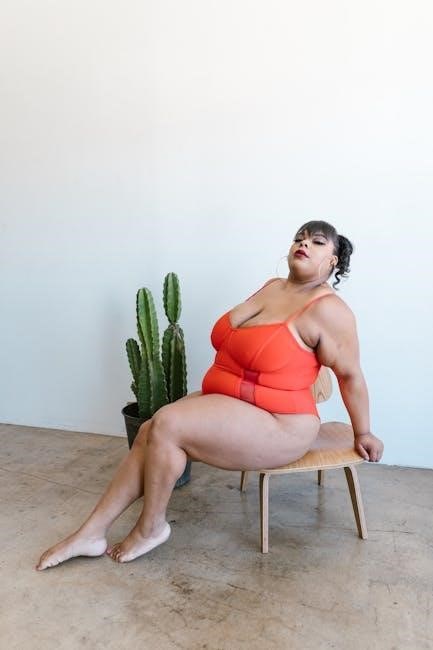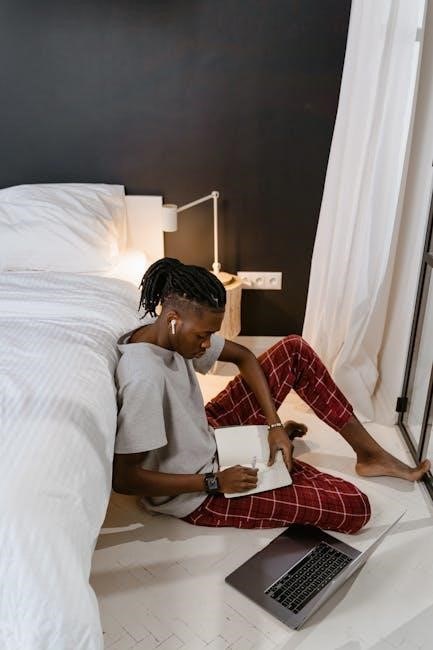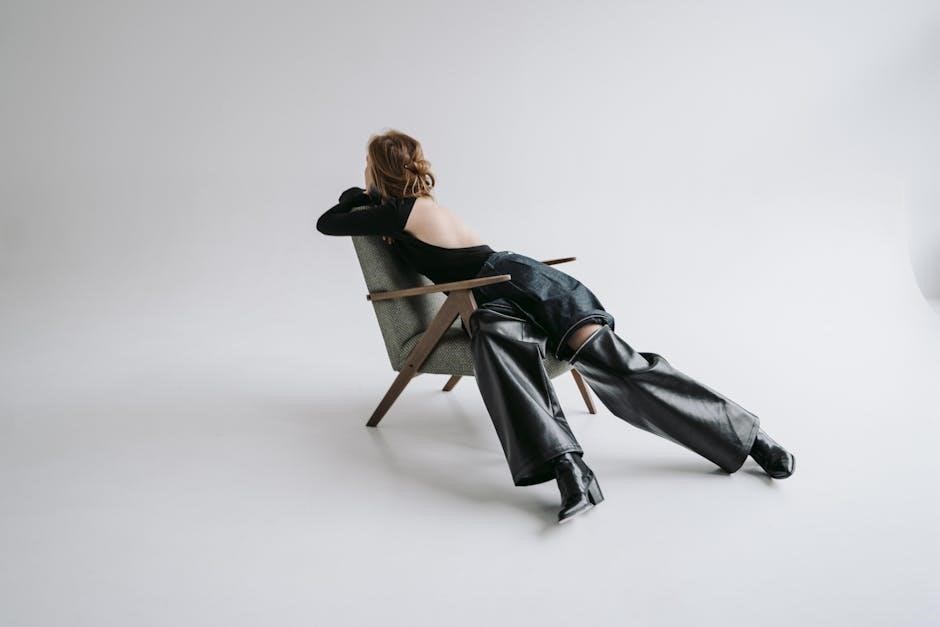A manual recliner chair offers a practical and comfortable seating solution, combining a lever-operated mechanism with a sturdy design for relaxation without reliance on electricity.
1.1 What is a Manual Recliner Chair?
A manual recliner chair is a seating option designed for comfort and relaxation, operated by a lever or handle to adjust its position. Unlike electric recliners, it relies on manual effort to recline, making it a cost-effective and straightforward choice. These chairs typically feature a sturdy steel frame, overstuffed armrests, and a footrest for enhanced comfort. They are ideal for small spaces and offer a space-saving design. Manual recliner chairs are also free from electrical dependencies, making them a practical option for everyday use. Their simple mechanism ensures durability and ease of maintenance, appealing to those seeking a reliable and affordable seating solution.
1.2 Key Differences from Electric Recliner Chairs

Manual recliner chairs differ significantly from electric ones, primarily in their operation and design. Unlike electric recliners, which use motors and require a power source, manual chairs rely on a lever or handle for adjustment. This eliminates the need for electricity, making them more affordable and easier to maintain. They are also lighter and more portable, often featuring a space-saving design that suits smaller rooms. While electric recliners offer smoother, automated adjustments, manual chairs provide a simpler, more durable option with no risk of mechanical failure from electrical components. This makes manual recliners a practical choice for those prioritizing cost and simplicity over advanced features.

Key Features of Manual Recliner Chairs
Durable steel frames ensure stability, while overstuffed armrests and backrests provide exceptional comfort. Footrests enhance relaxation, making manual recliners ideal for unwinding in style and support.
2.1 Durable Construction with Steel Frame
Manual recliner chairs are built with robust steel frames, ensuring long-lasting durability and stability. This construction supports heavy use, maintaining structural integrity over time. The steel frame is typically powder-coated for rust resistance, enhancing its lifespan. It provides a solid foundation for the chair’s mechanisms, allowing smooth reclining and footrest operations. With a focus on strength and reliability, the steel frame is a key feature that contributes to the chair’s overall longevity, making it a worthwhile investment for everyday use and relaxation.
2.2 Overstuffed Armrests and Backrest for Comfort
Manual recliner chairs feature overstuffed armrests and backrests designed for ultimate comfort. The plush cushioning provides excellent support, ensuring relaxation and reducing strain on the body. The armrests are padded to cradle the arms, while the backrest is generously filled to promote proper posture. This design allows users to lean back comfortably, with the cushioning conforming to their shape. The overstuffed elements are typically made from high-density foam, ensuring durability and maintaining their shape over time. This feature enhances the overall lounging experience, making the chair ideal for extended periods of rest and relaxation;

2.3 Footrest Design for Enhanced Relaxation
The footrest of a manual recliner chair is designed to provide enhanced relaxation by allowing users to elevate their legs comfortably. Constructed with durable materials, the footrest is built to withstand frequent use and supports the legs in an ergonomic position. Many models feature a smooth, easy-to-use mechanism that allows the footrest to extend and retract effortlessly. This design ensures optimal comfort, promoting better blood circulation and reducing strain on the lower body. The footrest is particularly beneficial for individuals seeking to unwind after a long day, offering a cozy and supportive surface to rest their legs.

How Manual Recliner Chairs Work
Manual recliner chairs operate using a lever mechanism and internal springs, allowing users to adjust positions smoothly without electricity, providing a reliable and straightforward relaxation experience.
3.1 Lever Mechanism for Adjusting Positions
The lever mechanism in manual recliner chairs enables users to effortlessly adjust their seating position. By pulling or pushing the lever, the chair transitions between upright and reclined modes, providing smooth, controlled movement. This mechanism is typically located on the side of the chair, making it easily accessible. The lever operates by engaging internal springs and gears, which facilitate the reclining function without the need for electricity. This simple yet effective system allows for a comfortable and customizable seating experience, catering to various relaxation needs. The lever’s design ensures durability and ease of use, making it a practical feature for everyday use.
3.2 Springs and Mechanisms Behind the Reclining Function

Manual recliner chairs rely on a combination of springs and internal mechanisms to facilitate smooth reclining. The springs store energy when the chair is reclined, ensuring a controlled return to the upright position. These mechanisms, often including gears and hinges, work in harmony with the lever to guide the chair through its range of motion. The system is designed for durability, allowing the chair to withstand repeated use. The springs and mechanisms are typically concealed within the frame, providing a seamless and efficient reclining experience. This design ensures that users can adjust their position effortlessly, making manual recliner chairs both functional and comfortable for everyday use.
Benefits of Manual Recliner Chairs
Manual recliner chairs offer affordability, space-saving design, and no electricity dependency. They provide health benefits by promoting proper posture and relaxation, ideal for everyday comfort and convenience.
4.1 Affordability Compared to Electric Recliners
Manual recliner chairs are significantly more affordable than electric recliners due to their simpler mechanisms. They eliminate the need for costly motors, making them a budget-friendly option for homeowners. Additionally, their lower price point allows consumers to enjoy comfort and functionality without financial strain. This affordability makes manual recliners accessible to a wider audience, including those on a tight budget. Moreover, their durability and long-lasting construction ensure that the investment remains cost-effective over time. Thus, manual recliner chairs are a practical choice for anyone seeking relaxation without the high expenses associated with electric models.
4.2 Space-Saving Design for Small Rooms
Manual recliner chairs are ideal for small spaces due to their compact and efficient design. Unlike bulky electric recliners, they often feature a zero-wall mechanism, allowing them to glide forward when reclining, saving valuable space. This design ensures they can fit seamlessly into smaller rooms without compromising comfort. Their lightweight and foldable construction further enhances their space-saving capabilities, making them perfect for apartments, studios, or cozy living areas. Additionally, their sleek profiles contribute to a clutter-free environment, ensuring functionality and style in limited spaces. This makes manual recliner chairs a practical choice for optimizing space while maintaining relaxation and comfort.
4.3 No Dependency on Electricity
Manual recliner chairs are highly advantageous as they require no electricity to function, offering a reliable and energy-efficient seating solution. This independence from power sources makes them ideal for homes with frequent outages or remote locations. Users can enjoy uninterrupted comfort without worrying about cords or electrical hazards. Additionally, eliminating the need for electricity reduces long-term energy costs and environmental impact. The manual mechanism ensures simplicity and durability, with less risk of mechanical failure compared to electric recliners. This feature also makes them safer, especially for children and pets, while providing consistent performance and relaxation whenever needed, free from any power constraints or dependencies.
4.4 Health Benefits for Posture and Relaxation
Manual recliner chairs offer significant health benefits, particularly for posture and relaxation. The ergonomic design provides optimal support for the back and neck, reducing muscle strain and promoting proper spinal alignment. The adjustable footrest enhances blood circulation, minimizing swelling in the legs and feet. This feature is especially beneficial for individuals with mobility issues or those recovering from injuries. Additionally, the ability to recline comfortably helps alleviate stress and anxiety, fostering a sense of calm and relaxation. By allowing users to customize their seating position, manual recliners cater to individual needs, ensuring long-term comfort and improving overall well-being.

Buying Guide for Manual Recliner Chairs
When selecting a manual recliner chair, consider space constraints, material durability, cushion comfort, and budget to ensure the best fit for your needs.
5.1 Considerations for Size and Space
When choosing a manual recliner chair, measure your room to ensure the chair fits comfortably. Consider models with a compact design or zero-wall recliners to save space in smaller areas. The chair should recline fully without hitting walls or furniture. Ensure there’s enough clearance behind the chair for smooth operation. Compact designs are ideal for apartments or cozy living rooms. Always check the dimensions and ensure the chair fits both in its upright and reclined positions. This ensures optimal comfort and functionality without compromising your space.
5.2 Importance of Material and Build Quality
The material and build quality of a manual recliner chair significantly impact its durability and comfort. Look for chairs with a sturdy steel frame, as they are more robust and long-lasting. Upholstery options like fabric, leather, or faux leather vary in comfort and maintenance needs. High-density foam cushioning ensures prolonged support and comfort. Durable stitching and reinforced joints are essential for withstanding frequent use. A well-constructed chair will provide years of reliable service. Prioritize materials that align with your lifestyle and preferences to ensure the recliner remains a comfortable and stylish addition to your home.
5.3 Ergonomic Design for Comfort
Ergonomic design is crucial for maximizing comfort in a manual recliner chair. Look for features like adjustable lumbar support, contoured backrests, and cushioned headrests to align with your body’s natural posture. A recliner with a footrest that elevates your legs to hip level can improve circulation and reduce strain on your lower back. Ensure the chair’s dimensions match your height and weight for optimal support. Proper ergonomic design ensures that the chair promotes relaxation and prevents discomfort, making it ideal for extended use. A well-designed recliner can enhance your overall seating experience and provide long-term health benefits.

5.4 Budget-Friendly Options
Manual recliner chairs offer cost-effective solutions for those seeking comfort without a hefty price tag. Many models are designed to be affordable while maintaining quality, making them accessible to a wide range of budgets. Look for chairs with essential features like sturdy steel frames, overstuffed armrests, and footrests, which provide excellent value for money. Online stores and sales often offer discounts, allowing you to find a reliable recliner at a lower cost. Budget-friendly options are ideal for small spaces or as a secondary chair, ensuring you can enjoy relaxation without compromising on comfort or durability.

Maintenance and Troubleshooting
Regular cleaning and lubrication of moving parts ensure smooth operation. Address squeaky noises by tightening loose joints or applying silicone spray. Inspect and replace worn mechanisms promptly.
6.1 Cleaning and Upholstery Care
Regular cleaning is essential to maintain the appearance and longevity of your manual recliner chair. For fabric upholstery, use a soft brush or vacuum cleaner to remove dust and debris. Spot clean stains with a gentle detergent solution, ensuring not to soak the fabric. Avoid harsh chemicals, as they may damage the material. For leather upholstery, use a leather conditioner to prevent cracking and maintain shine. Always test cleaning products on a small, inconspicuous area first. Dry the upholstery thoroughly after cleaning to prevent mildew. Regular maintenance ensures your recliner remains comfortable and visually appealing for years to come.
6.2 Lubricating Moving Parts
Lubricating the moving parts of your manual recliner chair is crucial for smooth operation and longevity. Use a silicone-based spray or powdered graphite to grease hinges, springs, and levers. Apply the lubricant sparingly to avoid attracting dust. Wipe off excess with a clean cloth to prevent residue buildup. Regular lubrication prevents squeaking, ensures the reclining mechanism works seamlessly, and reduces wear on metal components. Lubricate every 6-12 months or when you notice stiffness or noise. This simple maintenance step keeps your recliner functioning like new and enhances your overall comfort and relaxation experience. It’s an essential part of preserving your chair’s performance and durability.
6.3 Common Issues and Solutions
Common issues with manual recliner chairs include a stiff reclining mechanism, a stuck footrest, or a worn-out cushion. To address these, lubricate moving parts regularly and ensure proper alignment. If the footrest doesn’t retract, check for obstructions or tighten loose screws. For worn cushions, consider replacing them or adding extra padding. Addressing these issues promptly extends the chair’s lifespan and maintains comfort. Regular maintenance, such as cleaning and inspecting for wear, can prevent many problems. If issues persist, consult the manufacturer’s guide or contact a professional for assistance. Proper care ensures your recliner remains a cozy and reliable spot for relaxation.
